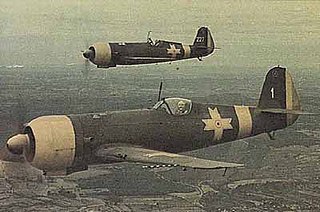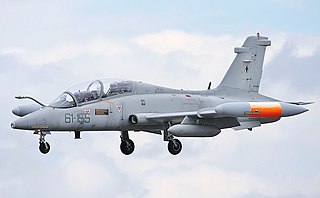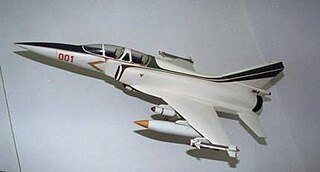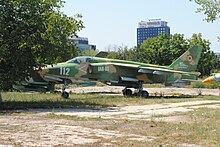Soko was a Yugoslav aircraft manufacturer based in Mostar, SR Bosnia and Herzegovina. The company was responsible for the production of many military aircraft for the Yugoslav Air Force.

The IAR 80 was a Romanian World War II low-wing monoplane, all-metal monocoque fighter and ground-attack aircraft. When it first flew, in 1939, it was comparable to contemporary designs being deployed by the airforces of the most advanced military powers such as the Hawker Hurricane and Bf 109E. Production problems and lack of available armament delayed entry of the IAR 80 into service until 1941. It remained in frontline use until May 1945.

The Aermacchi or Macchi MB-326 is a light military jet trainer designed and produced by the Italian aircraft manufacter Aermacchi. It is one of the most commercially successful aircraft of its type, being bought by more than 10 countries and produced under licence in Australia, Brazil and South Africa.

The Aermacchi MB-339 is a military jet trainer and light attack aircraft designed and manufactured by Italian aviation company Aermacchi.

The Soko J-22 Orao is a Yugoslavian twin-engined, subsonic ground-attack and aerial reconnaissance aircraft. It was developed and built in collaboration by SOKO in Yugoslavia and by Avioane Craiova in neighbouring Romania, being known in the latter as the IAR-93 Vultur.

The Mitsubishi F-1 is a Japanese swept-wing, single-seat, twin-engine supersonic strike aircraft that was in service with the Japan Air Self-Defense Force (JASDF) from 1978 to 2006. It was Japan's first domestically designed and built supersonic combat aircraft, jointly developed by Mitsubishi Heavy Industries. It is essentially a T-2 trainer airframe modified for a dedicated anti-ship and ground attack role.

The IAR 99Șoim (Hawk) is an advanced trainer and light attack aircraft capable of performing close air support and reconnaissance missions. The IAR 99 replaced the Aero L-29 Delfin and Aero L-39 Albatros as the jet trainer of the Romanian Air Force. The aircraft is of semi-monocoque design, with tapered wings and a swept-back tail unit. A large blade-type antenna installed beneath the nose on the port side of the fuselage gives the IAR 99 trainer a distinctive appearance.

The IAR 95 Spey was a Romanian project to produce a supersonic fighter jet for the Romanian Air Force. The project was started in the late 1970s and cancelled in 1981. Shortly after, the project was restarted again. The project was cancelled for good in 1988 due to lack of funds before a prototype could be built, although a full-scale mockup was being constructed.

The Soko G-4 Super Galeb, also referred to as N-62, is a Yugoslav single-engine, advanced jet trainer and light ground-attack aircraft designed by the Aeronautical Technical Institute at Žarkovo and manufactured by the SOKO aircraft factory in Mostar.

The Soko G-2 Galeb is a Yugoslav single engine, two-seater jet trainer and light ground-attack aircraft. The G-2 was developed during the 1950s by the Aeronautical Technical Institute at Žarkovo as a replacement for the Lockheed T-33 in service with the Yugoslav Air Force. Production started in 1965 at the Soko aircraft factory in Mostar, and ended in 1985 with 248 aircraft delivered. The G-2 had the distinction of being the first mass-produced jet aircraft in socialist Yugoslavia. It also served as a basis for the single-seat ground-attack J-21 Jastreb.

The Armstrong Siddeley Viper is a British turbojet engine developed and produced by Armstrong Siddeley and then by its successor companies Bristol Siddeley and Rolls-Royce Limited. It entered service in 1953 and remained in use with the Royal Air Force, powering its Dominie T1 navigation training aircraft until January 2011.

The Novi Avion was a fourth generation multi-role combat aircraft programme that was to be built by Yugoslav aircraft manufacturer SOKO.

The AIDC AT-3 Tzu Chung is an advanced jet trainer operated by the Republic of China Air Force (ROCAF). A total of sixty-two aircraft were manufactured by the Aerospace Industrial Development Corporation of Taiwan in collaboration with American aircraft manufacturer Northrop between 1984 and 1990. Two A-3 single-seat attack version were also built.

The Soko J-20 Kraguj is a light military, single-engine, low-wing single-seat aircraft with a metal airframe, capable of performing close air support, counterinsurgency (COIN), and reconnaissance missions, that was designed by VTI and manufactured by SOKO of Yugoslavia, first flown in 1962.
Avioane Craiova S.A. is an aeronautical company based in Ghercești, near Craiova, Romania. It has been involved in the manufacture of various military aircraft, including the IAR-93 Vultur ground-attack fighter, the IAR-99 advanced jet trainer/light attack aircraft, and the cancelled IAR-95 Spey fighter.

The Soko J-21 Jastreb, referred to as the J-1 Jastreb in some sources, is a Yugoslav single-seat, single-engine, light attack aircraft, designed by the Aeronautical Technical Institute (ATI) and Vojnotehnički Institut Beograd (VTI), in Belgrade and manufactured by SOKO in Mostar. Derived from the G-2 Galeb advanced jet trainer and light attack aircraft, it was designed in single-seat ground-attack and two-seat advanced flying/weapon training versions.

The ICAR Universal was a 1930s Romanian two seat monoplane trainer, touring and aerobatics aircraft.
The IAR-822 was an agricultural aircraft built in Romania in the 1960s. Based on the IAR-821, it was a conventional low-wing monoplane with fixed, tailwheel undercarriage and differed from its predecessor mainly in the choice of a horizontally opposed engine in place of a radial.

The IAR-823 is a civil and military trainer aircraft built in Romania from 1974 until 1983. It is a conventional low-wing monoplane with retractable tricycle undercarriage. The pilot and instructor sit side-by-side, and two more seats can be fitted behind them. The type was adopted by the Romanian Air Force as a primary trainer, and was also supplied to Romanian and Hungarian aeroclubs and the national flying school of Angola.

The FiatG.91Y is an Italian ground-attack and reconnaissance aircraft which first flew in 1966. Although resembling its predecessor, the Fiat G.91, the aircraft was in fact a complete redesign, a major difference being that it was equipped with a new twin-engine configuration, replacing the original single engine.





















